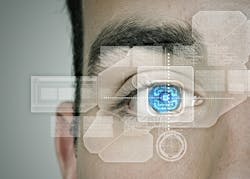Once seen as a solution for only a limited number of high-security installations, iris recognition products are quickly becoming one of the top methods of biometric identity verification for a variety of applications. The barriers that once stood in the way of their adoption, such as high deployment costs and throughput challenges, have now been addressed by many vendors, making the technology a viable solution for the access control needs of many end-users; however, while the acceptance of iris recognition continues to increase throughout the industry, the potential of the technology itself has only just begun to be unlocked.
For example, the integration of iris scanners with smartphones, which can already be found in the recently released Samsung Galaxy Note 7, could create an entirely new paradigm when it comes to applications like mobile payments and the protection of sensitive data, according to Mark Clifton, CEO of Princeton Identity. “Just like when Apple adopted the fingerprint, the adoption of fingerprint in the security sector went way up and I think we’re going to see the same thing with iris,” Clifton says. “I think you’re going to see a lot less credit card numbers and things like that. People are just going to start using their eyes.”
Of course, this type of capability is only available to the users of Samsung phones at the moment, but Clifton says they intend to take the same type of functionality and ease of use and extend it to physical access control. “We’re going to build devices that go in the door that will operate with [Samsung smartphones] but also authenticate the identities of other users,” Clifton adds.
Growing Acceptance
Anthony Antolino, chief marketing and business development officer for EyeLock, credits the evolution of technology in general for the level of acceptance and adoption that iris recognition products enjoy today. “In the iris space, from a physics perspective, you need a lot of illumination, cameras, imagers and optics. Many of those parts have to be constructed in such a way that the user in an everyday environment…can use it in a very easy and intuitive way. If you think about iris from 10, 15 or 20 years ago, that just wasn’t the case,” Antolino explains. “Anybody who had access to iris 20 years ago knows that you would have had to put these goggle-like things against your eyes and it was very invasive and not user friendly, so you saw it being used in government, law enforcement and the military, where user experience was not important or didn’t matter.”
Antolino says companies like EyeLock, which has been in business for a decade, stand poised to take advantage of what he describes as the “perfect storm” that is brewing relative to the technology developments that will pave the way for the proliferation of iris recognition solutions moving forward. “EyeLock has a number of different form factors that allow large enterprise corporations, chief security officers and such to utilize iris authentication in everyday environments – opening and closing doors, protecting data center racks, and incorporating it into the healthcare chain of provenance around identity,” Antolino says. “We’ve seen the market now wake up to how they can benefit and derive benefit from using iris.”
Because iris recognition solutions do not require physical contact with a reader the same way a fingerprint scanner does, Clifton says they can be used in a greater number of applications, as an accurate read is not dependent on the condition of someone’s fingers – which could impacted by the weather or the type of work they do. Additionally, the iris is a much more accurate alternative to fingerprints and other types of biometric identifiers.
“Ten fingerprints are about 130 points – 13 points per fingerprint – of identification. A single iris has over 250, so both eyes have more than 500 (identification points) compared to 130,” Clifton explains. “If you can match an iris, it’s about one in 1.4 million for a single iris as far as a false match. On both eyes, it’s like one in 1.4 trillion – it is almost like DNA’s really unique characteristics.”
Overcoming Misconceptions
Antolino says some misconceptions about iris still persist in the market – chief among them being that it remains unaffordable. “The technology used to be expensive,” he says. “Ten years ago it was really not cost effective. Even if you could get past the bad end user experience, cost was really prohibitive. The price has come down exponentially from where it used to be. Iris devices used to be anywhere from $5,000 to $10,000 apiece, and that didn’t include the labor and service component for an integrator to go and install them.”
Mohammed Murad, vice president of global sales and business development for Iris ID Systems, says another challenge that remains in the market is getting people to not lump the capabilities of fingerprint and iris together. “A lot of people generalize biometrics as fingerprint, so getting them to understand that it is non-contact, non-invasive, fast and a lot more accurate and easy to use,” Murad says. “That’s an educational challenge that we have and we have done a pretty decent job of getting people to understand that but there is still a lot of work to do in that area.”
When it comes to throughput, Murad says the problems of yesteryear of being able to process a high-number of people at an entryway via iris have all but been eliminated. “When we can comfortably tell you that we can do 20 to 25 people per minute in a habituated population, that’s actually very good,” Murad adds. “In time and attendance, we have done factories where we process 4,500 people for a shift. Those are the education pieces we have a challenge with.”



